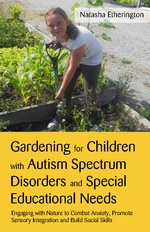 Natasha Etherington is an award-winning horticultural therapist and volunteer master gardener, and author of the new book Gardening for Children with Autism Spectrum Disorders and Special Educational Needs. She designs gardens and adapts horticultural activities to enable people with barriers to enjoy the experience of gardening.
Natasha Etherington is an award-winning horticultural therapist and volunteer master gardener, and author of the new book Gardening for Children with Autism Spectrum Disorders and Special Educational Needs. She designs gardens and adapts horticultural activities to enable people with barriers to enjoy the experience of gardening.
In this interview, Natasha Etherington talks to us about her love for gardening and her background as a horticultural therapist, and explains how parents and teachers can easily introduce gardening activities into a child’s routine.
Can you explain what your job as a horticultural therapist entails? How did you get into this field, and begin working with kids with ASDs?
After emigrating to Canada in 2006, I retrained as an horticultural therpist (HT) at The VanDusen Botanical Gardens in Vancouver, British Columbia, Canada, following my Master Gardener training which was also at The VanDusen. I’ve always loved gardening, and in the UK used to live next door to Kew Gardens which is now a World Heritage Site and absolutely beautiful. It was my sanctuary from a busy career at BBC2, home of Gardeners’ World.
My role is to help people of various ages and abilities to experience garden related activities, and to understand the benefits of working with plants. Working with plants is therapeutic. Being an HT is a challenging role; I must be flexible and inspire a sense of curiosity in the people I work with. In 2009 I approached my mentor Christine Pollard, HTM, with the idea of designing a Therapeutic Garden* at Pitt Meadows Elementary School, and running a weekly HT garden program for children with special needs. At the time I began the program I had no idea there were even any children with Autism Spectrum Disorders (ASD) at the school. In 2010 the garden was awarded a Certificate of Appreciation for Accessibility from the Maple Ridge City Council. Success to me is when the teaching staff incorporates gardening into the children’s schedules.
*See the book for Natasha’s designs.
 What are the benefits of gardening for children with ASD and special needs?
What are the benefits of gardening for children with ASD and special needs?
Getting a child with ASD into a garden has so many benefits, not least that they are given some autonomy outside. The most immediate benefit will be a sense of relief and welcome break from the classroom environment. Whilst gardening, we’re practicing social interaction and life skills, and working with soil and plants helps to reduce tactile defensiveness. Learning basic horticultural skills educates in context, and along the way you will also see an increase in language and communication skills. Of course, I explore this more and provide activities in the book.
What is the best way for teachers and parents to easily introduce gardening activities into a child’s routine?
At school, gardening/sensory breaks should be placed into a child’s schedule. This may be once a week or twice a week, but should always take place at a fixed time on a fixed day for continuity. The garden should be viewed as an outdoor classroom.
At home, gardening should be introduced when parents can find a moment to devote some quality time to their child and leave their cell phone behind. Parents will feel a sense of relief too. Easy introductory activities are all laid out in the book for those with little horticultural knowledge.
You use a mindfulness approach with the children that you work with. Can you explain why this is such an effective approach in the garden?
I find that mindfulness teachings relate fundamentally to the interconnectedness of Mother Earth, which fits perfectly as an approach for someone working with plants every day. This approach requires me to be open to experiences as they occur, which is crucial to working with children with ASD who can be quite busy and on the move. Mindfulness teaches one to be non-judgmental which I find children really appreciate. I listen. I don’t judge by what they do or say unless it is dangerous. My role is to be compassionate and enable children to understand the benefits of and experience working with plants.
The benefits for the teacher or parent leading the activities are that they, in turn, will learn to take time to stop and appreciate the wonder of Mother Nature and to share these moments with their child. In the present moment you will take a minute to stop, to acknowledge a thing of beauty such as a lady beetle or a dragonfly which has come to rest on your arm. You will greet this fellow creature and consider their short life cycle and their role in a plant’s life – you will be amazed. You might take it one step further and sit down, waiting until the dragonfly resumes flight. By doing this together with your child or student, you’re sharing experiences and making connections with one another that you are unable to do in a busy classroom. You can find out what motivates your young learner, which will help you build on their goals whether they are life skills or academic. In every chapter in the book, I point to this approach and provide tips for engaging with children through the use of a variety of activities. Don’t listen to anyone that says a child with ASD is just too busy to take time to notice a lady beetle or dragonfly. I have seen children with ASD quite captivated by many creatures, including birds visiting the bird feeder, interacting with them with bird song mimicry. Just so you know, I haven’t reached enlightenment yet…
What is your favorite gardening activity in the book, and why?
I’m a gardener, I love to dig! Being outside in the fresh air, digging and then perhaps planting, nurturing and watching a seedling grow. That’s satisfaction.
Can you tell us a bit about the “Enabling Garden” that you have designed specifically for wheelchair users?
I felt it was important for a student in a wheelchair whom I was introduced to to have ownership over one area of the garden. The Enabling Garden is an A-frame garden (using untreated cedar wood) which is inset into a long border to avoid being knocked or nudged as other students use the garden. It is placed between the vegetable patch and the digging plot to maximize the potential for social interaction. There is a universal access, adjustable potting table which provides space for two wheelchairs to work side-by-side or for a support worker. This garden provides a place for a child to get their hands into the soil and start planting seedlings or perhaps annuals. There are two hanging baskets for the child to use indoors when the weather is prohibitive.
It’s important to add that this was built with a grant from The Rick Hansen Foundation. I have placed the design for the Enabling Garden in the book so it is freely available.
Copyright © Jessica Kingsley Publishers 2011.
Article contains so many fruitful information which will be liked by the readers as in my opinion this is the best article in this category.